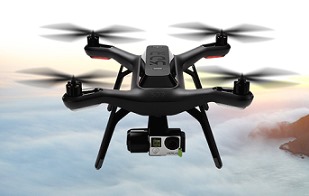APM 2.6 Set (external compass)
The APM 2.6 is a complete open source autopilot system and the bestselling technology that won the prestigious 2012 Outback Challenge UAV competition. It allows the user to turn any fixed, rotary wing or multirotor vehicle (even cars and boats) into a fully autonomous vehicle; capable of performing programmed GPS missions with waypoints. Available with top or side connectors.
APM 2.6는 완전한 오픈 소스 자동조정장치 시스템이며 권위있는 2012 Outback Challenge UAV 대회에서 수상한 가장 많이 팔린 기술입니다. 이것은 사용자가 어떤 고정된, 회전하는 날개 혹은 멀티로터(multirotor) 운송수단(심지어 자동차 그리고 보트)을 완전히 자율적인 운송수단으로 가능하게 합니다; 경유지를 정해 프로그램된 GPS 미션을 수행하는 것이 가능합니다. 위 혹은 옆 커넥터와 함께 가능합니다.
This revision of the board has no onboard compass, which is designed for vehicles (especially multicopters and rovers) where the compass should be placed as far from power and motor sources as possible to avoid magnetic interference. (On fixed wing aircraft it's often easier to mount APM far enough away from the motors and ESCs to avoid magnetic interference, so this is not as critical, but APM 2.6 gives more flexibility in that positioning and is a good choice for them, too). This is designed to be used with the 3DR uBlox GPS with Compass (see option below), so that the GPS/Compass unit can be mounted further from noise sources than APM itself.
보드의 이번 수정판은 온보드 compass를 실장하지 않습니다. 이것은 자기장 간섭을 가능한 피하기 위해서 파워나 모터로부터 멀리 떨어져 위치해야만 하는 compass를 가진 운송수단(특히 멀티콥터 그리고 로버)을 위하여 설계되었습니다. (고정 날개 비행체에서는 자기장 간섭을 피하기 위해 모터나 전자변속기(ESC)로부터 충분히 떨어져 APM를 탑재하는 것이 종종 쉽습니다 그래서 이것은 중요하지 않지만 APM 2.6은 어디에 탑재하느냐에 좀더 유연성을 주고 그것들을 위해서 역시 좋은 선택이 됩니다). 이것은 compass(see option below)를 가진 3DR uBlox GPS을 사용하도록 설계되어졌습니다. 그 결과, GPS/Compass는 APM 자체보다 잡음 소스로부터 좀더 멀리 탑재하는 것이 가능합니다.

APM 2.6 requires a GPS unit with an onboard compass for full autonomy.
APM 2.6은 완전한 자율조정을 위해서 온보드 compass를 가진 GPS를 필요합니다.
If you are using APM 2.6 with a GPS module that does not have a compass sensor, you must use a stand-alone external compass.
만일 여러분이 compass 센서를 가지지 않는 GPS 모듈과 APM 2.6을 사용한다면 여러분은 독립적인 외장 compass를 사용해야만 합니다.
Features:
- Arduino Compatible!
- Can be ordered with top entry pins for attaching connectors vertically, or as side entry pins to slide your connectors in to either end horizontally.
- Includes 3-axis gyro, accelerometer and magnetometer, along with a high-performance barometer.
(3축 자이로를 탑재한 가속도계와 지자기계, 고성능의 고도계)
- Onboard 4 MegaByte Dataflash chip for automatic datalogging.
(자동적인 데이터 기록을 위한 4Mbyte 크기의 플레쉬 메모리 탑재)
- Optional off-board GPS, uBlox LEA-6H module with Compass.
(지자기 센서를 포함하여 외장 GPS 모듈인 uBlox LEA-6H의 선택 가능)
- One of the first open source autopilot systems to use Invensense's 6 DoF Accelerometer/Gyro MPU-6000.
(3축 자이로 가속도 센서로 MPU-6000)
- Barometric pressure sensor upgraded to MS5611-01BA03, from Measurement Specialties.
(공기압을 측정하여 고도를 감지할 수 있는 고도 센서로서 MS5611-01BA03으로 개선됨)
- Atmel's ATMEGA2560 and ATMEGA32U-2 chips for processing and usb functions respectively.
(USB 통신을 위해서 ATMEGA32U-2 칩을 내장)
APM(AutoPilot Mega) History
APM v2.5 - on board compass.
APM v2.5.2 ~ v2.8 - APM v2.5와 하드웨어와 소프트웨어는 동일하지만, PCB상에서 외란에 대한 간섭을 최소화하기 위해서 외장 지자기 센서를 사용할지 말지에 대한 점퍼스위치를 갖추고 있습니다. 기존에는 내장 Mediatek GPS를 사용하지만 APM v2.6에서는 외장 Ublox GPS/Compass 모듈의 사용이 가능합니다.


















